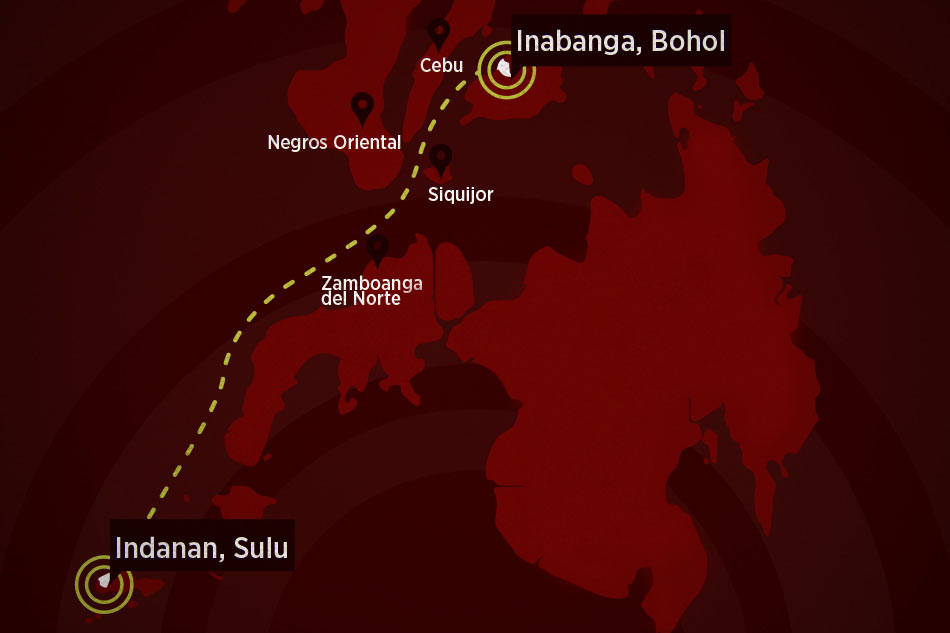
April 6 to 7: The Armed Forces of the Philippines (AFP) monitors a group of Abu Sayyaf in Indanan, Sulu. The group leaves Sulu bound for central Visayas, prompting the AFP to alert its intelligence community nationwide.
April 9: The US Embassy warns its citizens against traveling to central Visayas, including Cebu and Bohol, over "unsubstantiated yet credible" reports of kidnapping threats.
April 10: The AFP receives reports of the presence of 3 pump boats, with around 11 heavily armed men, in Inabanga, Bohol.
Residents first spot the armed men Monday morning entering Inabanga River and going to Barangay Napo in the town of Inabanga.
The police also receive reports that the bandits "could have been Muslims" since they were aboard boats only used in Mindanao.
The AFP would later disclose that the group was supposed to carry out "a plan for kidnapping."
Had they been successful, the Abu Sayyaf incursion in Bohol, a major tourist destination, would been the first in the area in years.
April 11: A firefight between joint military and police forces and the Abu Sayyaf starts at around 5 a.m.
WATCH: Bohol clash captured on cam
A policeman and three soldiers are killed. The bodies of five armed men are recovered (as of 2 p.m., April 11).
At least 700 individuals in Inabanga leave their homes due to the firefight.
More countries issue travel advisories following reports of the clash.
The United Kingdom urges its citizens to be "especially vigilant" in traveling to Central Visayas, citing the United States' warning of terror activity in the region.
The Australian government also advises its people against traveling to Central Visayas and Mindanao, including the Zamboanga Peninsula, and the Sulu Archipelago and southern Sulu Sea.
The Canadian government, likewise, issues a travel warning urging its citizens to "exercise a high degree of caution" when going to the Philippines and "avoid all travel" to Mindanao and the southern Sulu Sea.
New Zealand classifies traveling to central and western Mindanao as an "extreme risk" to its citizens' security.
April 12: AFP confirms the death of Abu Sayyaf leader Muamar Askali, alias Abu Rami.
Capt. Jojo Mascariñas, spokesperson of the Army's 302nd Brigade, identifies the government's casualties as:
- 2nd Lieutenant Espelito Saldua, Jr.;
- Corporal Meljun Cajaban ;
- Sergeant John Dexter Duero;
- PO2 Rey Anthony Nazareno.
As of posting, government troops are still tracking 5 Abu Sayyaf members who survived the firefight.
The AFP says the remaining bandits fled after an overnight siege near a remote village, where helicopter gunships were used against them. The bandits' local contact also fled the community.
The French Embassy in Manila also releases a travel advisory, citing “credible reports of threats of kidnapping by terrorist groups in the Central Visayas, particularly in Cebu and Bohol.”
AFP Spokesman Brig. Gen. Restituto Padilla says they received information over the past few weeks about a potential activity from lawless elements to disturb the peace in central Visayas.
Sources: AFP press conference, ABS-CBN News field reports, Agence France-Presse, Reuters
http://news.abs-cbn.com/news/04/12/17/timeline-abu-sayyaf-in-bohol

No comments:
Post a Comment
Note: Only a member of this blog may post a comment.